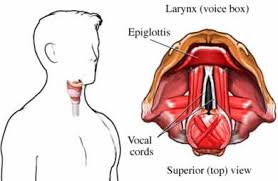There are different parts that make people produce sound, and those are the vocal cords, the epiglottis, the ventricular folds and the pharynx. The vocal chords vibrate, creating different pitches, and different sounds. Their vibrations are sound waves. The disturbance, or the thing that causes the vibrations, is the air that is pushed up from your lungs. The vocal chords for people with deeper voice are usually longer then the vocal chords of people with voices which are much higher. However, the sounds produced by your larynx, are majorly affected by your teeth, mouth, and tongue. Depending on how you move your tongue, or teeth, the sound that comes out will be different. Let's take two letters as an example: "d" and "t". When you first look at them, and look at the way you pronounce them, you can see that the way of pronouncing them is quite similar, but not completely the same. When you pronounce "t", your tongue touches your teeth more. A similraty that both of these letters have is that they are both produced when the breath is completely, or partially stopped, like all consonants. I am sure that you have noticed that men usually have a deeper, and lower-pitched voice than women. This is because during puberty, testosterone deepens men's voices, and makes their vocal boxes expand. However, when they are little, both boys and girls have a voice of similar pitch. Again, this is because the younger boys haven't gone through puberty yet, and their voices didn't deepen yet.
Larynx, and the vocal chords, can get an infaction, and can stop working, just like some other organs in our body. The disease that can cause this is called laryngitis. Laryngitis is an inflammation of the larynx. It makes your voice really hoarse, and makes the vocal cords irritated. There are several factors that can cause laryngitis, and those are overuse of the vocal cords, over-consumption of cigarettes and alcohol, etc.
For this experiment, there wasn't really a special procedure that we followed. All we did was pair up with a partner, and pronounce different words, such as "sister", "boat", etc. Then, we observed what we do with our mouth, teeth and tongue to say certain words.
For the table below, it was really difficult to record data for a few reasons. Firstly, it was quite difficult to see where the sound was open, and when was stopped (when you stopped the air coming out from your mouth and vocal cords by using your mouth, teeth or tongue). In the table below,I just found one letter that I believed wasn't completely closed, and let a bit of air pass out of your mouth.

Larynx, and the vocal chords, can get an infaction, and can stop working, just like some other organs in our body. The disease that can cause this is called laryngitis. Laryngitis is an inflammation of the larynx. It makes your voice really hoarse, and makes the vocal cords irritated. There are several factors that can cause laryngitis, and those are overuse of the vocal cords, over-consumption of cigarettes and alcohol, etc.
For this experiment, there wasn't really a special procedure that we followed. All we did was pair up with a partner, and pronounce different words, such as "sister", "boat", etc. Then, we observed what we do with our mouth, teeth and tongue to say certain words.
For the table below, it was really difficult to record data for a few reasons. Firstly, it was quite difficult to see where the sound was open, and when was stopped (when you stopped the air coming out from your mouth and vocal cords by using your mouth, teeth or tongue). In the table below,I just found one letter that I believed wasn't completely closed, and let a bit of air pass out of your mouth.

No comments:
Post a Comment